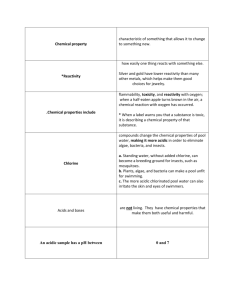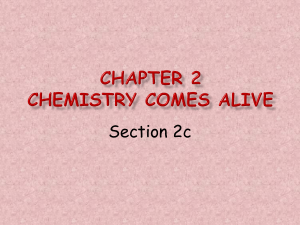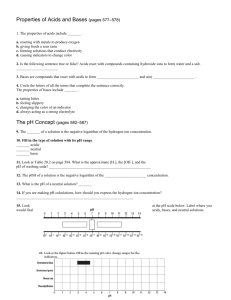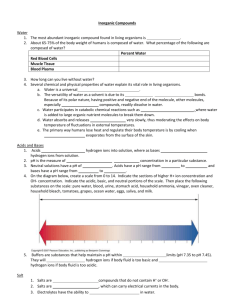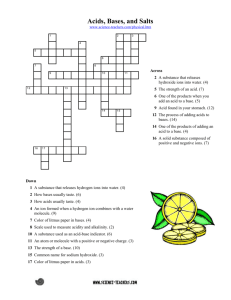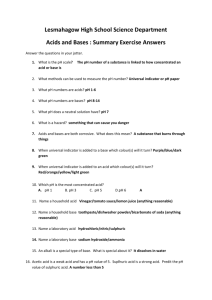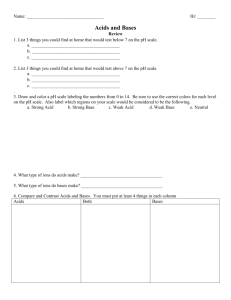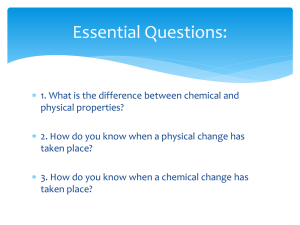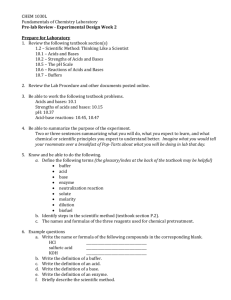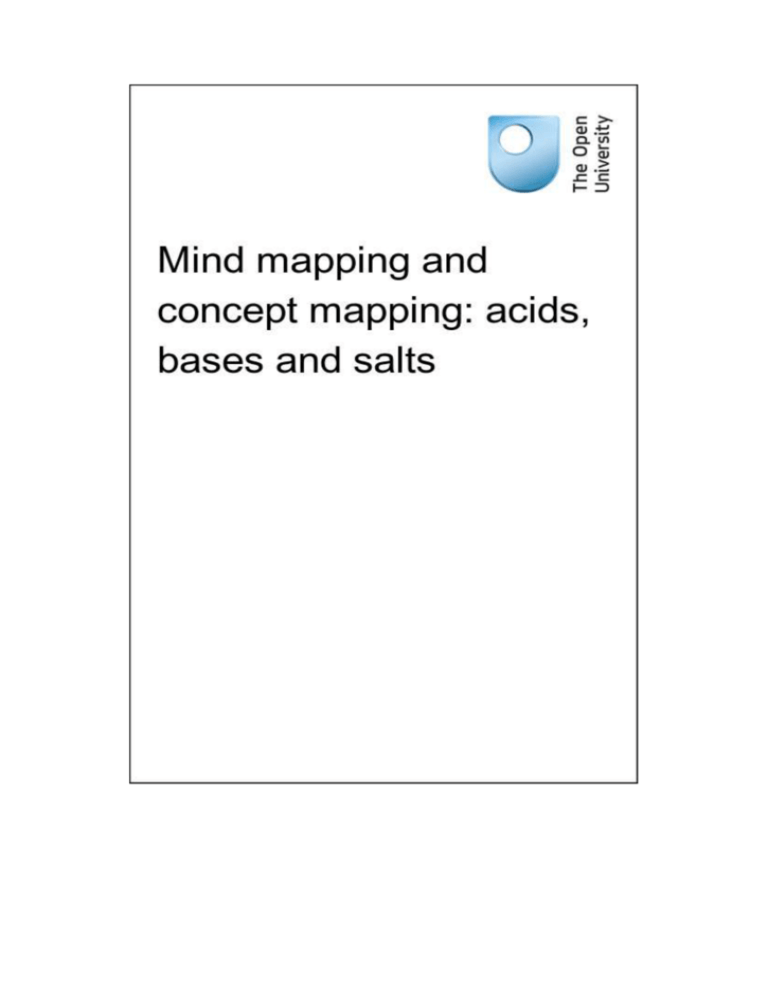
Mind mapping and concept mapping: acids, bases and salts TI-AIE
TI-AIE Teacher Education through School-based Support in India
TI-AIE
Mind mapping and concept mapping:
acids, bases and salts
Page 2 of 30
http://www.open.edu/openlearnworks/course/view.php?id=1911
27th May 2015
Mind mapping and concept mapping: acids, bases and salts TI-AIE
Copyright © 2015 The Open University
All rights reserved. No part of this publication may be reproduced, stored in a retrieval system, transmitted
or utilised in any form or by any means, electronic, mechanical, photocopying, recording or otherwise,
without written permission from the publisher.
Cover image © NASA.
Page 3 of 30
http://www.open.edu/openlearnworks/course/view.php?id=1911
27th May 2015
Mind mapping and concept mapping: acids, bases and salts TI-AIE
Contents
What this unit is about
What you can learn in this unit
Why this approach is important
1 Introducing mind maps
2 Drawing a mind map
3 Making a concept map
4 Summary
Resources
Resource 1: Examples of mind maps
Resource 2: An acids, bases and salts mind map
Resource 3: Assessment criteria for a mind map
Resource 4: Monitoring and giving feedback
Resource 5: Example of a concept map
Resource 6: Using groupwork
Additional resources
References
Acknowledgements
Page 4 of 30
http://www.open.edu/openlearnworks/course/view.php?id=1911
27th May 2015
Mind mapping and concept mapping: acids, bases and salts TI-AIE
What this unit is about
This unit is about how you can develop skills to help students to process information
effectively and present it in the form of mind maps and concepts maps.
A mind map organises information and presents it in a visual way so it is easier to
remember. A mind map is created around a central word or phrase and associated
ideas, words and concepts are added in hierarchical branches. The creation of mind
maps supports the development of memory, visual thinking and problem solving
skills. Creating a mind map involves structuring knowledge about a topic, in a way
that can help to consolidate understanding.
Mind maps are personal and there are no right answers. It is helpful for students to
look at each other’s mind maps, so this unit will also help you to organise ‘peer
review’ in your classroom.
A concept map is similar, but places more emphasis on making connections between
key words and concepts. A concept map still uses a visual diagrammatic
representation of knowledge and aims to show the conceptual relationships between
the entries. It does this with lines, arrows and linking text. The key words and the
linking words should make a meaningful sentence. Concept maps are particularly
helpful for eliciting students’ understanding.
This unit will introduce mind maps and concept maps in the context of acids, bases
and salts. This topic requires students to remember quite a lot of factual information
and to use technical terms correctly. Mind mapping and concept mapping will help
your students to make sense of the information that they need to learn and can be used
in many topics in science.
Page 5 of 30
http://www.open.edu/openlearnworks/course/view.php?id=1911
27th May 2015
Mind mapping and concept mapping: acids, bases and salts TI-AIE
What you can learn in this unit
How to create your own mind maps.
How to help your students to use mind mapping in order to support
their understanding of scientific concepts.
Some strategies for organising peer review in your classroom.
How to construct a concept map to show how concepts are linked.
Page 6 of 30
http://www.open.edu/openlearnworks/course/view.php?id=1911
27th May 2015
Mind mapping and concept mapping: acids, bases and salts TI-AIE
Why this approach is important
Being successful at science at secondary school requires your students to understand
and remember large amounts of information. They must also be able to master the
specialised vocabulary of science. Everyone learns in different ways and as a teacher
it is your responsibility to support the learning of all students. Mind mapping appeals
to visual learners and can help them to remember information more easily. However,
making a mind map or a concept map involves engaging with and processing
information that will help all students to improve their understanding.
There are other important advantages that mind mapping and concept mapping can
bring to your teaching:
They help students to think creatively and independently.
They can help to structure the topic in students’ minds by providing
them with an overview of the topic. This helps students to store,
package and retain the concepts and link one lesson to another.
They provide an opportunity for peer review. Peer review helps
students to develop evaluative skills that in turn will help them to take
responsibility for their own learning.
They link well with brainstorming. Students can work in groups to
brainstorm everything they can remember about a topic. Converting
the brainstorm in to a mind map or a concept map involves careful
thought and will help students to organise the information for
themselves.
Mind maps and concepts maps will tell you a great deal about how
your students are thinking and the depth of their understanding. You
can use this to inform your planning.
Pause for thought
How do you prefer to learn?
Have you used mind maps and concepts maps in the past?
If so – what challenges did you find?
There is a tendency for teachers to teach in the way in which they prefer to learn. By
being aware of your own preferences, you will be able to be explicit about introducing
variety into your teaching. Even if you are not a visual learner, it is worth
remembering that the process of constructing a mind map or a concept map is as
important as the finished product.
Page 7 of 30
http://www.open.edu/openlearnworks/course/view.php?id=1911
27th May 2015
Mind mapping and concept mapping: acids, bases and salts TI-AIE
There is no right answer when drawing a mind map, but some are more useful than
others. This can be disconcerting for some students who might lack confidence in
their own ability. Looking at many examples will help them, and you, develop skills
in this area.
Page 8 of 30
http://www.open.edu/openlearnworks/course/view.php?id=1911
27th May 2015
Mind mapping and concept mapping: acids, bases and salts TI-AIE
1 Introducing mind maps
Activity 1: Looking at mind maps
You should try this activity on your own, or with a colleague. You will need to refer
to Resource 1.
Look at the examples of mind maps on a variety of topics.
What do they all have in common?
Which do you think would be the most helpful and why?
Imagine you were trying to explain to someone how to draw a mind
map. Make a list of instructions that they could use.
It is important to remember that the process of constructing a mind map is just as
important as the end product. The features that all mind maps have in common are:
the main idea, subject (heading) or focus is identified in a central
image, word or phrase
the main themes (sub-headings) radiate from the central image as
‘branches’, which may be drawn in different colours
topics that are further removed from the central idea are represented as
‘twigs’ of the relevant branch.
A good mind map will be well-organised and will contain lots of detail.
Before you ask your students to draw a mind map, it is helpful for them so see some
examples. In Case Study 1, Mr Ditta used a game to introduce mind maps to his Class
X.
Case Study 1: Games and mind maps
Mr Ditta introduces mind maps to his class.
Exams were approaching and I wanted to find ways of helping my students to revise. I
like using mind maps to organise information, so I organised a game to help my
students understand some of the benefits of mind maps.
First of all I drew a detailed mind map of acids, bases and salts [see Resource 2]. I put
it on a table at the front of the room. I divided my students into groups of four. There
were 40 students in the class, so that made ten groups. Each group had a large piece of
paper and one student was chosen to be the scribe. Only that person was allowed to
write anything. The idea was that each group would make a copy of the mind map.
One person from each group came to the front table and had 20 seconds to look at the
mind map. They went back to their place and had to tell the scribe what to write. After
Page 9 of 30
http://www.open.edu/openlearnworks/course/view.php?id=1911
27th May 2015
Mind mapping and concept mapping: acids, bases and salts TI-AIE
about a minute, another person in the group then came to the front and looked for 20
seconds. Each person in the group had two ‘looks’, except for the scribe, who just had
to write what they were told.
At the end I stuck my mind map on the blackboard so that they could all see it and
compare it with theirs. We had a vote about which was the best one and then I asked
that group to describe how they had tackled the problem.
Petra had taken the lead and organised a systematic approach. She went first and had
had memorised the six branches. She then instructed her classmates to concentrate on
one of the branches so that they could get as much detail as possible. It really
highlighted the structure of a good mind map and I am sure it helped when they did
one for themselves. Also – it was good fun. They did not realise that they had actually
done some good revision of acids, bases and salts!
Page 10 of 30
http://www.open.edu/openlearnworks/course/view.php?id=1911
27th May 2015
Mind mapping and concept mapping: acids, bases and salts TI-AIE
2 Drawing a mind map
The best use of mind maps is as a revision tool for making sense of a body of
information. So the best time to get your students to draw a mind map (Figure 1) is
when you have completed a topic. They will have forgotten some of the things that
you covered at the beginning, so in the next activity, you will start with a brainstorm
in order to help them remember some of the information.
Figure 1 A group of students working on a mind map in class.
Activity 2: Helping your students draw a mind map
Before the lesson you will need to decide on the topic that you will be covering. Write
out the criteria that you will use to judge the mind maps on a large piece of paper,
which you will be able to stick on the wall (Resource 3).
Gather your students round the front of the class, so they can all see
the blackboard. Get them to volunteer anything that they remember
about the topic you have just completed. As they offer ideas, write
them on the blackboard. Write the ideas as your students suggest
them and don’t attempt to group the ideas at this stage.
When they run out of suggestions and the blackboard is full, explain
that you want them to do a mind map to summarise the topic. Check
that they understand what you mean and remind them of the main
features of a mind map. Students should work in pairs to produce a
mind map. Draw their attention to the criteria for a good mind map on
the wall.
When they have finished, either collect them in for you to mark, or
conduct a peer review exercise.
Page 11 of 30
http://www.open.edu/openlearnworks/course/view.php?id=1911
27th May 2015
Mind mapping and concept mapping: acids, bases and salts TI-AIE
Peer review is helpful for students as it helps them to understand the assessment
process. Once they understand the criteria against which they are being judged, they
will be able to take more responsibility for their own learning. However, they will
need help in the form of clear criteria for the task and clear instructions about how to
give feedback to each other. See Resource 4 for more information on monitoring and
giving feedback.
Video: Monitoring and giving feedback
Case Study 2: Peer reviews
Mrs Rakhi teaches her students about peer review, using mind maps that they have
made.
In the last lesson, my class had worked in pairs to produce a mind map. I explained
that today they were going to assess each other’s work. Before we started, we had a
discussion about how to give feedback. I explained that it was important to highlight
the good points. If something could be improved, I encouraged them to think of ways
of making the criticism constructive to help each student move forward with their
learning. Here are some of the examples I used:
‘It looks very muddled’: I can see the main structure, but perhaps
you could have used different colours to make the detail clearer.
‘There is nothing on preparing salts’: You have covered a lot of
detail. It would be even better if you had included something on the
methods of preparing salts.
‘Some of the science is wrong’: It is very well presented, but you
should check some of the details.
‘It is not detailed enough’: The structure is very helpful. It would be
good to have a bit more detail at the end of the branches.
For the peer review, I asked each pair to join up with another pair and swap mind
maps. I wrote the criteria for assessing the mind maps on the blackboard so that
everyone could see it clearly.
Each pair assessed the mind map they had against the criteria. I said, ‘Write down two
things that you really like about the mind map and suggest one thing that could be
improved.’ Then they swapped back again and I gave them a few minutes to make
some changes to their mind maps.
Page 12 of 30
http://www.open.edu/openlearnworks/course/view.php?id=1911
27th May 2015
Mind mapping and concept mapping: acids, bases and salts TI-AIE
Finally, I asked each pair to put their mind map on the desk and I let them walk
around the room and look at each other’s. I did this because I think that the best way
to get better at drawing mind maps is to see lots of examples and to think about what
makes some better than others. We had a vote on which was the best one, and I asked
three different people to explain why they had voted for that one.
Pause for thought
Have you ever used peer review as a way of assessing students’ work?
If so, how did it go?
If not, what do you think the challenges will be?
Research (Hattie, 2012) shows that one of the things which has the most impact on
students’ learning is getting feedback on their work. Obviously they get feedback
from you, but by making use of peer review and self-assessment, your students will
get more feedback and will get a better understanding of the assessment process.
However, if they have not assessed work before, they will need help. They need clear
assessment criteria and guidance about how to give feedback. Starting with work that
has been produced in a group is less threatening that looking at the work of
individuals. Also, you need to think carefully about who is giving feedback and make
sure that students have the opportunity to work with different people. It is important
that they trust and respect the person giving the feedback.
Page 13 of 30
http://www.open.edu/openlearnworks/course/view.php?id=1911
27th May 2015
Mind mapping and concept mapping: acids, bases and salts TI-AIE
3 Making a concept map
A concept map places more emphasis on making connections between key words and
concepts than a mind map. It uses a visual diagrammatic representation of knowledge
with lines and arrows to make links between key words. The idea is that the key
words and the linking words make a meaningful sentence.
Concept maps are particularly helpful for assessing students’ understanding of a topic.
There is an example of a concept map in Resource 5.
Activity 3: Making a concept map
You should do this activity on your own and then with your class. Your class should
do the activity in groups of three of four.
1. Make a list of about 20 key words associated with the topic of acids,
bases and salts.
2. Write each word on a separate piece of paper.
3. Place the words on a large piece of poster paper. Put words that are
related near to each other. When you are happy with the arrangement,
stick the words down with glue or sticky tape.
4. Draw lines to connect the terms that are related. Write a few words on
the connecting arrow to explain the connection. The words that are at
one end of the arrow, on the arrow and at the other end of the arrow
should make a sentence.
5. When your students do this activity, look carefully at their concept
maps. What do they tell you about their understanding? Are there
topics that they are finding difficult? Is there a topic you need to
discussion again in the next lesson?
Case Study 3: Thinking about how to make groups
Mr Singh thinks about how to divide students into groups.
I decided to get my class to make a concept map. At first I thought I would use mixed
ability groups on the basis that the high attainers would be able to help my students
who find science difficult. This has worked well in the past, but there is a danger that
the people who are confident will take over. This time, I put my students into groups
based on their achievement in the last test.
While they were writing the key words onto small pieces of paper, I talked to the
groups who I knew would be confident and checked that they understood the task. I
was then able to devote myself to the two groups who I knew would find it difficult.
In fact, I decided to link the two groups and we did a few examples together. Once
they got the idea, I left them to do a few by themselves. But I kept going back to see
how they were getting on.
Page 14 of 30
http://www.open.edu/openlearnworks/course/view.php?id=1911
27th May 2015
Mind mapping and concept mapping: acids, bases and salts TI-AIE
Overall, this approach worked very well. The high attainers produced detailed concept
maps with a lot of detail. They really stretched themselves. The concept maps
produced by some of the other groups were not as good. But that did not matter,
because in the process of doing the activity they had learnt a lot. They had helped
each other and looked up definitions of words that they did not know. They were not
dominated by people who were very confident. It also gave me the opportunity to see
exactly who understood what and who needed more help. It helped me to identify
areas to discuss again with my students.
Pause for thought
How do you usually organise the groups in your classroom?
It is a good idea to vary the way in which you split your students into groups.
Sometimes, it is helpful for them to work with friends as this will give them
confidence. Sometimes it will be helpful for the high attainers to be able to support
people who find science more difficult. If the task you have set is open-ended (such as
a mind map or a concept map) with no single ‘right answer’, it is a good opportunity
to let your students find their own level. High attainers will really challenge each
other and you will be free to provide support for those that need more help. Read
Resource 6 to find out more about using groupwork in your classroom.
Video: Using groupwork
Page 15 of 30
http://www.open.edu/openlearnworks/course/view.php?id=1911
27th May 2015
Mind mapping and concept mapping: acids, bases and salts TI-AIE
4 Summary
You can use mind maps or concepts maps in any topic as they are essentially a
revision tool. They will help them to organise information into a form that is easier to
remember. They are also a very good way of providing your students with the
opportunity to talk about their ideas and to learn from each other. A mind map or a
concept map done by an individual student will tell you a great deal about the level of
their understanding, so you will be in a better position to support their learning
effectively.
Page 16 of 30
http://www.open.edu/openlearnworks/course/view.php?id=1911
27th May 2015
Mind mapping and concept mapping: acids, bases and salts TI-AIE
Resources
Resource 1: Examples of mind maps
Figure R1.1 An example of a mind map.
Page 17 of 30
http://www.open.edu/openlearnworks/course/view.php?id=1911
27th May 2015
Mind mapping and concept mapping: acids, bases and salts TI-AIE
Figure R1.2 An example of a mind map.
Resource 2: An acids, bases and salts mind map
Page 18 of 30
http://www.open.edu/openlearnworks/course/view.php?id=1911
27th May 2015
Mind mapping and concept mapping: acids, bases and salts TI-AIE
Figure R2.1 An acids, bases and salts mind map.
Resource 3: Assessment criteria for a mind map
Organisation
Does the mind map cover the key ideas?
Is the information arranged logically?
Scientific content
Is the science on the mind map correct?
Does the mind map help explain the topic?
Have all the important points been included?
Presentation
Does the mind map look attractive?
Would the mind map help me to learn the information?
Resource 4: Monitoring and giving feedback
Improving students’ performance involves constantly monitoring and responding to
them, so that they know what is expected of them and they get feedback after
completing tasks. They can improve their performance through your constructive
feedback.
Page 19 of 30
http://www.open.edu/openlearnworks/course/view.php?id=1911
27th May 2015
Mind mapping and concept mapping: acids, bases and salts TI-AIE
Monitoring
Effective teachers monitor their students most of the time. Generally, most teachers
monitor their students’ work by listening and observing what they do in class.
Monitoring students’ progress is critical because it helps them to:
achieve higher grades
be more aware of their performance and more responsible for their
learning
improve their learning
predict achievement on state and local standardised tests.
It will also help you as a teacher to decide:
when to ask a question or give a prompt
when to praise
whether to challenge
how to include different groups of students in a task
what to do about mistakes.
Students improve most when they are given clear and prompt feedback on their
progress. Using monitoring will enable you to give regular feedback, letting your
students know how they are doing and what else they need to do to advance their
learning.
One of the challenges you will face is helping students to set their own learning
targets, also known as self-monitoring. Students, especially struggling ones, are not
used to having ownership of their own learning. But you can help any student to set
their own targets or goals for a project, plan out their work and set deadlines, and selfmonitor their progress. Practising the process and mastering the skill of selfmonitoring will serve them well in school and throughout their lives.
Listening to and observing students
Most of the time, listening to and observing students is done naturally by teachers; it
is a simple monitoring tool. For example, you may:
listen to your students reading aloud
listen to discussions in pair or groupwork
observe students using resources outdoors or in the classroom
observe the body language of groups as they work.
Make sure that the observations you collect are true evidence of student learning or
progress. Only document what you can see, hear, justify or count.
As students work, move around the classroom in order to make brief observation
notes. You can use a class list to record which students need more help, and also to
Page 20 of 30
http://www.open.edu/openlearnworks/course/view.php?id=1911
27th May 2015
Mind mapping and concept mapping: acids, bases and salts TI-AIE
note any emerging misunderstandings. You can use these observations and notes to
give feedback to the whole class or prompt and encourage groups or individuals.
Giving feedback
Feedback is information that you give to a student about how they have performed in
relation to a stated goal or expected outcome. Effective feedback provides the student
with:
information about what happened
an evaluation of how well the action or task was performed
guidance as to how their performance can be improved.
When you give feedback to each student, it should help them to know:
what they can actually do
what they cannot do yet
how their work compares with that of others
how they can improve.
It is important to remember that effective feedback helps students. You do not want to
inhibit learning because your feedback is unclear or unfair. Effective feedback is:
focused on the task being undertaken and the learning that the student
needs to do
clear and honest, telling the student what is good about their learning
as well as what requires improvement
actionable, telling the student to do something that they are able to do
given in appropriate language that the student can understand
given at the right time – if it’s given too soon, the student will think ‘I
was just going to do that!’; too late, and the student’s focus will have
moved elsewhere and they will not want to go back and do what is
asked.
Whether feedback is spoken or written in the students’ workbooks, it becomes more
effective if it follows the guidelines given below.
Using praise and positive language
When we are praised and encouraged, we generally feel a great deal better than when
we are criticised or corrected. Reinforcement and positive language is motivating for
the whole class and for individuals of all ages. Remember that praise must be specific
and targeted on the work done rather than about the student themselves, otherwise it
will not help the student progress. ‘Well done’ is non-specific, so it is better to say
one of the following:
Page 21 of 30
http://www.open.edu/openlearnworks/course/view.php?id=1911
27th May 2015
Mind mapping and concept mapping: acids, bases and salts TI-AIE
Using prompting as well as correction
The dialogue that you have with your students helps their learning. If you tell them
that an answer is incorrect and finish the dialogue there, you miss the opportunity to
help them to keep thinking and trying for themselves. If you give students a hint or
ask them a further question, you prompt them to think more deeply and encourage
them to find answers and take responsibility for their own learning. For example, you
can encourage a better answer or prompt a different angle on a problem by saying
such things as:
It may be appropriate to encourage other students to help each other. You can do this
by opening your questions to the rest of the class with such comments as:
Correcting students with a ‘yes’ or ‘no’ might be appropriate to tasks such as spelling
or number practice, but even here you can prompt students to look for emerging
patterns in their answers, make connections with similar answers or open a discussion
about why a certain answer is incorrect.
Page 22 of 30
http://www.open.edu/openlearnworks/course/view.php?id=1911
27th May 2015
Mind mapping and concept mapping: acids, bases and salts TI-AIE
Self-correction and peer correction is effective and you can encourage this by asking
students to check their own and each other’s work while doing tasks or assignments in
pairs. It is best to focus on one aspect to correct at a time so that there is not too much
confusing information.
Resource 5: Example of a concept map
Resource 6: Using groupwork
Groupwork is a systematic, active, pedagogical strategy that encourages small groups
of students to work together for the achievement of a common goal. These small
groups promote more active and more effective learning through structured activities.
The benefits of groupwork
Groupwork can be a very effective way of motivating your students to learn by
encouraging them to think, communicate, exchange ideas and thoughts, and make
decisions. Your students can both teach and learn from others: a powerful and active
form of learning.
Groupwork is more than students sitting in groups; it involves working on and
contributing to a shared learning task with a clear objective. You need to be clear
about why you are using groupwork for learning and know why this is preferable to
lecturing, pair work or to students working on their own. Thus groupwork has to be
well-planned and purposeful.
Page 23 of 30
http://www.open.edu/openlearnworks/course/view.php?id=1911
27th May 2015
Mind mapping and concept mapping: acids, bases and salts TI-AIE
Planning groupwork
When and how you use groupwork will depend on what learning you want to achieve
by the end of the lesson. You can include groupwork at the start, the end or midway
through the lesson, but you will need to allow enough time. You will need to think
about the task that you want your students to complete and the best way to organise
the groups.
As a teacher, you can ensure that groupwork is successful if you plan in advance:
the goals and expected outcomes of the group activity
the time allocated to the activity, including any feedback or summary
task
how to split the groups (how many groups, how many students in each
group, criteria for groups)
how to organise the groups (role of different group members, time
required, materials, recording and reporting)
how any assessment will be undertaken and recorded (take care to
distinguish individual assessments from group assessments)
how you will monitor the groups’ activities.
Groupwork tasks
The task that you ask your students to complete depends on what you what them to
learn. By taking part in groupwork, they will learn skills such as listening to each
other, explaining their ideas and working cooperatively. However, the main aim is for
them to learn something about the subject that you are teaching. Some examples of
tasks could include the following:
Presentations: Students work in groups to prepare a presentation for
the rest of the class. This works best if each group has a different
aspect of the topic, so they are motivated to listen to each other rather
than listening to the same topic several times. Be very strict about the
time that each group has to present and decide on a set of criteria for a
good presentation. Write these on the board before the lesson.
Students can the use the criteria to plan their presentation and assess
each other’s work. The criteria could include:
Was the presentation clear?
Was the presentation well-structured?
Did I learn something from the presentation?
Did the presentation make me think?
Problem solving: Students work in groups to solve a problem or a
series of problems. This could include conducting an experiment in
science, solving problems in mathematics, analysing a story or poem
in English, or analysing evidence in history.
Creating an artefact or product: Students work in groups to develop
a story, a piece of drama, a piece of music, a model to explain a
Page 24 of 30
http://www.open.edu/openlearnworks/course/view.php?id=1911
27th May 2015
Mind mapping and concept mapping: acids, bases and salts TI-AIE
concept, a news report on an issue or a poster to summarise
information or explain a concept. Giving groups five minutes at the
start of a new topic to create a brainstorm or mind map will tell you a
great deal about what they already know, and will help you pitch the
lesson at an appropriate level.
Differentiated tasks: Groupwork is an opportunity to allow students
of different ages or attainment levels to work together on an
appropriate task. Higher attainers can benefit from the opportunity to
explain the work, whereas lower attainers may find it easier to ask
questions in a group than in a class, and will learn from their
classmates.
Discussion: Students consider an issue and come to a conclusion. This
may require quite a bit of preparation on your part in order to make
sure that the students have enough knowledge to consider different
options, but organising a discussion or debate can be very rewarding
for both you and them.
Organising groups
Groups of four to eight are ideal but this will depend on the size of your class, the
physical environment and furniture, and the attainment and age range of your class.
Ideally everyone in a group needs to see each other, talk without shouting and
contribute to the group’s outcome.
Decide how and why you will divide students into groups; for
example, you may divide groups by friendship, interest or by similar
or mixed attainment. Experiment with different ways and review what
works best with each class.
Plan any roles you will give to group members (for example, note
taker, spokesperson, time keeper or collector of equipment), and how
you will make this clear.
Managing groupwork
You can set up routines and rules to manage good groupwork. When you use
groupwork regularly, students will know what you expect and find it enjoyable.
Initially it is a good idea to work with your class to identify the benefits of working
together in teams and groups. You should discuss what makes good groupwork
behaviour and possibly generate a list of ‘rules’ that might be displayed; for example,
‘Respect for each other’, ‘Listening’, ‘Helping each other’, ‘Trying more than one
idea’, etc.
It is important to give clear verbal instructions about the groupwork that can also be
written on the blackboard for reference. You need to:
Page 25 of 30
http://www.open.edu/openlearnworks/course/view.php?id=1911
27th May 2015
Mind mapping and concept mapping: acids, bases and salts TI-AIE
direct your students to the groups they will work
in according to your
plan, perhaps designating areas in the classroom where they will work
or giving instructions about moving any furniture or school bags
be very clear about the task and write it on the board in short
instructions or pictures. Allow your students to ask questions before
you start.
During the lesson, move around to observe and check how the groups are doing. Offer
advice where needed if they are deviating from the task or getting stuck.
You might want to change the groups during the task. Here are two techniques to try
when you are feeling confident about groupwork – they are particularly helpful when
managing a large class:
‘Expert groups’: Give each group a different task, such as
researching one way of generating electricity or developing a
character for a drama. After a suitable time, re-organise the groups so
that each new group is made up of one ‘expert’ from all the original
groups. Then give them a task that involves collating knowledge from
all the experts, such as deciding on what sort of power station to build
or preparing a piece of drama.
‘Envoys’: If the task involves creating something or solving a
problem, after a while, ask each group to send an envoy to another
group. They could compare ideas or solutions to the problem and then
report back to their own group. In this way, groups can learn from
each other.
At the end of the task, summarise what has been learnt and correct any
misunderstandings that you have seen. You may want to hear feedback from each
group, or ask just one or two groups who you think have some good ideas. Keep
students’ reporting brief and encourage them to offer feedback on work from other
groups by identifying what has been done well, what was interesting and what might
be developed further.
Even if you want to adopt groupwork in your classroom, you may at times find it
difficult to organise because some students:
are resistant to active learning and do not engage
are dominant
do not participate due to poor interpersonal skills or lack of
confidence.
To become effective at managing groupwork it is important to reflect on all the above
points, in addition to considering how far the learning outcomes were met and how
well your students responded (did they all benefit?). Consider and carefully plan any
adjustments you might make to the group task, resources, timings or composition of
the groups.
Page 26 of 30
http://www.open.edu/openlearnworks/course/view.php?id=1911
27th May 2015
Mind mapping and concept mapping: acids, bases and salts TI-AIE
Research suggests that learning in groups need not be used all the time to have
positive effects on student achievement, so you should not feel obliged to use it in
every lesson. You might want to consider using groupwork as a supplemental
technique, for example as a break between a topic change or a jump-start for class
discussion. It can also be used as an ice-breaker or to introduce experiential learning
activities and problem solving exercises into the classroom, or to review topics.
Page 27 of 30
http://www.open.edu/openlearnworks/course/view.php?id=1911
27th May 2015
Mind mapping and concept mapping: acids, bases and salts TI-AIE
Additional resources
An introductory lecture on YouTube:
https://www.youtube.com/watch?v=HW6OzOeOZOI (accessed 20
May 2014)
Revision notes and exam questions:
http://www.excellup.com/classten/scienceten/acidbasesalt.aspx
(accessed 20 May 2014)
An activity sheet on making indicators:
http://www.raftbayarea.org/ideas/Acid%20or%20Base.pdf (accessed
20 May 2014)
A quiz on acids, bases and salts:
http://www.docbrown.info/page03/AcidsBasesSalts/AcidBaseQmcF.
htm (accessed 20 May 2014)
Page 28 of 30
http://www.open.edu/openlearnworks/course/view.php?id=1911
27th May 2015
Mind mapping and concept mapping: acids, bases and salts TI-AIE
References
Hattie, J. (2012) Visible Learning for Teachers: Maximising Impact on Learning.
Abingdon, UK: Routledge.
Mortimer, E.F. and Scott, P.H. (2003) Meaning Making in Secondary Science
Classrooms. Maidenhead, UK: Open University Press.
Petty, G. (2009) Evidence-based Teaching: A Practical Approach. Cheltenham, UK:
NelsonThornes.
Page 29 of 30
http://www.open.edu/openlearnworks/course/view.php?id=1911
27th May 2015
Mind mapping and concept mapping: acids, bases and salts TI-AIE
Acknowledgements
Except for third party materials and otherwise stated below, this content is made
available under a Creative Commons Attribution-ShareAlike licence
(http://creativecommons.org/licenses/by-sa/3.0/). The material acknowledged below is
Proprietary and used under licence for this project, and not subject to the Creative
Commons Licence. This means that this material may only be used unadapted within
the TESS-India project and not in any subsequent OER versions. This includes the use
of the TESS-India, OU and UKAID logos.
Grateful acknowledgement is made to the following sources for permission to
reproduce the material in this unit:
Resource 1 (top): cell mind map – Mrs Shreen Abbas, Mrs Alka Chopra, Mrs
Nilanjana Lal and Mrs Alka Masih
(http://www.freewebs.com/indiaenglishforum/lamartiniere.htm).
Resource 1 (bottom): cells summary mind map (http://311sandratan.wikispaces.com/1_Cells), made available under Creative Commons
(http://creativecommons.org/licenses/by-sa/3.0/).
Every effort has been made to contact copyright owners. If any have been
inadvertently overlooked the publishers will be pleased to make the necessary
arrangements at the first opportunity.
Video (including video stills): thanks are extended to the teacher educators,
headteachers, teachers and students across India who worked with The Open
University in the productions.
Page 30 of 30
http://www.open.edu/openlearnworks/course/view.php?id=1911
27th May 2015

